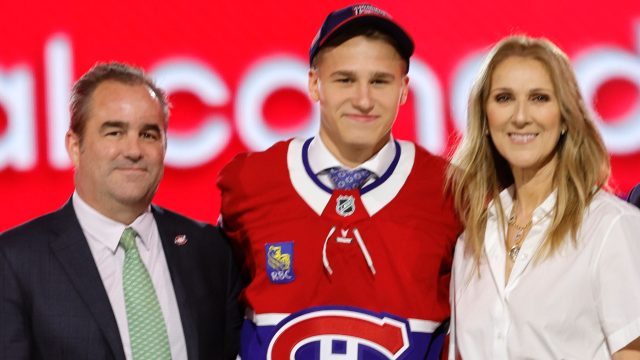
The recently contested Hlinka Gretzky Cup, won by Team Canada over Team Czechia, marked the beginning of a new scouting cycle. The countdown to the 2025 NHL Draft has officially started.
All 32 NHL clubs were in attendance in Edmonton at the beginning of the month, and teams will now begin the process of planning travel, organizing critical date calendars and scouting coverage requirements to view top prospects throughout the world.
The 2024-25 NHL regular season will commence on Oct. 4 when the Buffalo Sabres face-off versus the New Jersey Devils in the NHL Global Series at O2 Arena in Prague, Czechia. It won’t take long before teams start to identify their strengths and weaknesses compared to the rest of the league. The inevitable trade winds will start to blow as contenders attempt to add to their rosters while, at the same time, rebuilding organizations will look to restock their cupboards with prospects and draft capital hoping to eventually return to playoff competition.
When teams start to discuss including first-round draft picks in potential trades, one of the strategies includes a clause that protects top 10 draft slots. It’s common for a pick acquired in trade to come with a stipulation that it’s “top-10 lottery protected” in the current draft cycle. Other instances punt the selection down the road a year (2025 to 2026 for example) and remove the lottery protection in the process.
The bottom line is teams highly value top 10 picks far more than any other slot.
With that value in mind, here’s an early look at 10 prospects who could go that early in 2025.
No. 1: James Hagens, Boston College (NCAA)
5-foot-10, 172 pounds. Left-shot centre.
Hagens is the consensus pre-season number one prospect. He is a dynamic forward who craves having the puck on his stick to make plays, and contributed an incredible 9G-13A in seven games at the U18 World Championship in April. Hagens is equally as dynamic offensively as 2024 first overall pick Macklin Celebrini. His commitment to defence isn’t the same as Celebrini’s, but he has an entire year of development to improve his detail in that zone.
Hagens projects to be a top-line scoring centre who will pick opponents apart on the power play and off the rush. His offensive upside wins out for me. His skill is elite.
No. 2: Porter Martone, Brampton Steelheads (OHL)
6-foot-3, 196 pounds. Right-shot winger.
In my opinion, Martone leans shooter more than distributor. He’s a massive winger who has added considerable strength to his frame in the past year. Martone uses his stature and strength to create space for himself in high danger scoring areas. Pucks are on and off his stick in a flash. His combination of power and puck touch is elite. Martone produced 33G-38A in 60 regular season games for the Steelheads last season and then contributed 5G-12A in seven games for gold medal-winning Team Canada at the U18 World Championship.
No. 3: Anton Frondell, Djurgardens (Sweden)
6-foot, 196 pounds. Left-shot centre.
It was impossible to not notice Frondell and his goal scoring prowess on the international stage last season. He uses his combination of skating, size, strength and hockey sense to find open space in the offensive zone and rip pucks. He’s a lethal shooter from the weak side flank on the power play. Opponents have to respect him when he’s up to speed and attacking through the neutral zone. By the time the draft rolls around next June, it wouldn’t surprise me to hear Frondell’s name being debated even higher than the No. 3 slot I currently have him in to start the season.
No. 4: Matthew Schaefer, Erie Otters (OHL)
6-foot-1, 175 pounds. Left-shot defenceman.
Schaefer captained Team Canada at the Hlinka/Gretzky Cup and led by example the entire tournament. He logged an incredible amount of ice time in all situations and contributed 2G-4A offensively. Schaefer is an elite skater who has the defensive commitment to match up against top opponents and kill penalties. The two-way/transitional defender also quarterbacks the power play. He’s a complete player. Schaefer is very young for this draft class, with a birthday falling on Sept. 5. If he was born 11 days later, he wouldn’t qualify for this draft cycle.
No. 5: Ivan Ryabkin, Dynamo Moscow (Russia)
6-foot, 170 pounds. Left-shot centre.
Recent draft classes have included some very high-end Russian prospects and Ryabkin is next in that line. Ryabkin is another forward on this list who wants the puck on his stick in the offensive zone. He’s a difference maker with fantastic puck touch and a threat off the rush. What I also appreciate about his game is the fact he isn’t shy about engaging physically below the goal line to win pucks and direct the play to the net. His combination of skill and will is enticing.
No. 6: Michael Misa, Saginaw Spirit (OHL)
6-foot, 173 pounds. Left-shot forward.
Misa was granted exceptional status in 2022 and was selected first overall in the ensuing OHL Draft. He was part of the Memorial Cup-winning Spirit team in June, contributing five assists in the tournament. Misa produced 29G-46A in 67 regular season games last year. Misa plays the game the right way. He’s above the play when his team doesn’t have clear possession and tracks back to assist defensively. He has the skill and vision to make plays on his weak side flank on the power play. I consider Misa equal parts shooter and distributor. I’m comfortable with Misa being deployed in a variety of roles. He’s competitive and trustworthy.
No. 7: Logan Hensler, Wisconsin Badgers (NCAA)
6-foot-2, 196 pounds. Right-shot defenceman.
Hensler is a name to keep a close eye on as the season progresses. The two-way defenceman is an excellent skater in open space and also has fantastic agility and edges in small areas. He uses his length, and quickness, to get to pucks ahead of opponents and make plays with it. Hensler has some secondary offence in his game as well. He’s a coveted right-shot defender who can be deployed in all situations. Scouts will be flocking to Wisconsin’s campus to view Hensler in high leverage scenarios at the college level as a freshman this fall.
No. 8: Roger McQueen, Brandon Wheat Kings (WHL)
6-foot-5, 192 pounds. Right-shot centre.
McQueen brings a combination of size and skill. He’s a solid skater for his stature, especially in open ice, and is very hard to contain when he works off the boards and heads to the net in the offensive zone. McQueen produced 21G-30A in 53 regular season games last season and benefited from suiting up for Team Canada on the international stage.
No. 9: Malcolm Spence, Erie Otters (OHL)
6-foot, 193 pounds. Left-shot winger.
There are three elements I look for in a player before breaking down their skill attributes and forecasting their role at the NHL level: Skating ability, Hockey IQ, and competitiveness (especially in big games and under duress). Spence meets my expectations and adds offence as an attractive element. He plays the game fast, creates turnovers, is a threat off the rush and has the hockey sense to be deployed in a variety of roles. Spence produced 19G-43A for Erie last season and benefitted from his experience suiting up for Team Canada at the worlds. Spence was used in a variety of roles for Canada and contributed 3G-4A in seven games. Erie will be a destination for the scouting fraternity this season, where both Spence and Schaefer will suit up for the Otters.
No. 10: William Moore, USNTDP
6-foot-2, 160 pounds. Left-shot forward.
I’m already debating internally about the 10th slot on my draft list for 2025, but Moore wins out for now. He is a dual citizen who was born in Mississauga and played his minor hockey in the Greater Toronto Hockey League with the Mississauga Senators and Toronto Marlies. He’s a Boston College commit, but Moore was also selected in the first-round (18th overall) of the OHL draft by the London Knights in 2023.
Moore produced 23G-20A last season, as well as a very impressive 5G-7A at the U17 World Challenge. Moore is sneaky off the rush and has outstanding puck touch in high danger areas. He shields pucks using his size and length to his advantage. In time Moore will add more strength to his go along with his height. I’m forecasting even more offensive impact on the horizon as he matures physically.
On the cusp…
As I mentioned, I was splitting hairs when I landed on Moore for the 10th slot on this list. Here are two other names I considered:
Charlie Trethewey, USNTDP
6-foot-1, 190 pounds. Right-shot defenceman.
Trethewey provides better than secondary offence (12G-23A last season), pushes back physically, and can be used in all situations. When space opens up on his strong side in the offensive zone Trethewey has displayed he can beat goalies from range with a heavy and accurate shot.
Caleb Desnoyers, Moncton Wildcats (QMJHL)
6-foot-1, 178 pounds. Left-shot centre.
Desnoyers is a crafty forward who can play the game quickly, or slow things down to dissect his options and make plays. He’s also reliable off the puck in the defensive zone and committed enough to be used in a variety of roles. I’m expecting Desnoyers to improve upon his 20G-36A season from last year.









